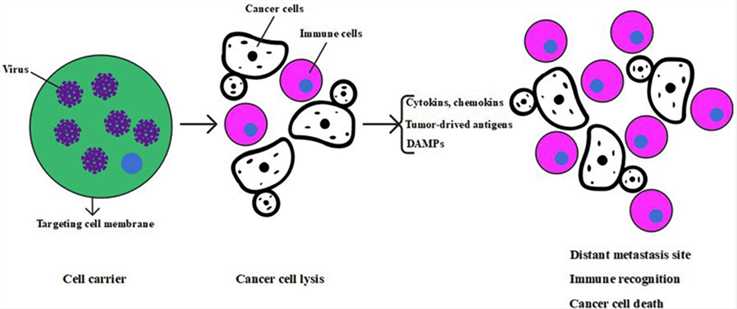Replication Enhancement of Oncolytic Vaccinia Virus
Development of Oncolytic Vaccinia Virus
The development of the oncolytic vaccinia virus presents great potentials for tumor treatment. The enhance of virus replication has been served as a promising method to improve tumor efficacy. The different gene deletions and insertions give oncolytic viruses the ability to target tumors, which leads to additional personalized medicine applications in tumor therapy.
 Fig.1 Anticancer mechanism of oncolytic virus. (Cao, 2020)
Fig.1 Anticancer mechanism of oncolytic virus. (Cao, 2020)
A34R Mutation
Exist in the outer membrane of extracellular enveloped virus (EEV), A34R refers to the gene that encodes a C-type lectin-like glycoprotein, gp22-24 with the functions of plaque formation, EEV release, EEV infectivity, and virus virulence. Studies have shown that the A34R deletion mutant presents a series of advantages in the tumor model, such as tumor-selective replication, potent immune evasion, and virus spreading. A34R mutation is also a novel method for vaccine development.
MMP-loaded Oncolytic Vaccinia Virus
Matrix metalloproteinases (MMPs) are zinc-dependent endopeptidases expressed as inactive zymogens. In the activated state, MMPs are important for the degradation of extracellular matrix (ECM) components and ECM is the hindrance for viral cell-to-cell spreading. In this case, the insertion of MMP in the oncolytic vaccinia virus would promote intra-tumoral viral dissemination and accelerate tumor regression.
IL4&IL10-loaded Oncolytic Vaccinia Virus
The expression of IL4 and IL10 largely helps for viral infection and replication, as well as angiogenesis inhibition. In this case, the insertion of the IL-4 or IL-10 gene into the vaccinia virus vector is beneficial to prevent the clearance of immature viruses and assist virus replication.
Measurements of Virus Replication
To obtain precise and unique spacio-temporal measurements of virus replication in vivo, the non-invasive imaging of reporter transgene expression has been served as a powerful method.
- Bioluminescence imaging
- Fluorescence imaging
- Nuclear medicine-based imaging
Based on luciferase catalysis, the novel bioluminescence imaging has been widely used in biomedicine, such as gene expression patterns research, bacterial pathogen tracking, gene expression tracking, and monitoring of tumor cell growth and regression. For oncolytic viruses, it has been used to monitor viral replication in vivo and biodistribution in preclinical models.
Fluorescence imaging is a rapid and inexpensive method to track the replication of the virus in vitro. What's more, fluorescent proteins expressed in oncolytic viruses might also be applied for the pre-clinical test as well as the prediction of therapeutic outcomes.
Nuclear medicine-based imaging is reliant on a scanner that detects and locates radioactive tracers. In the oncolytic virus expressing reporter genes, the change in the biodistribution of the tracer molecule at the reporter gene expression site causes the local concentration of the tracer to replicate in the virus.
Creative Biolabs has been a long-term expert in the field of oncolytic virus. Based on our advanced platforms and extensive experience, now we provide the one-stop oncolytic vaccinia virus enhancement service for our clients all over the world.
Reference
- Cao, G.; et al. The oncolytic virus in cancer diagnosis and treatment. Frontiers in Oncology. 2020, 10. Distributed under Open Access license CC BY 4.0, without modification.
